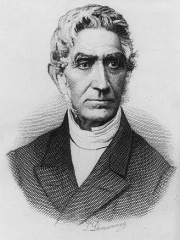
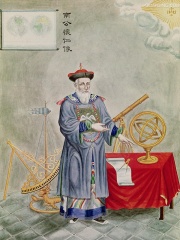
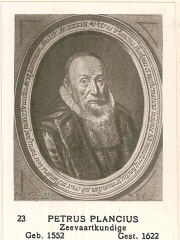


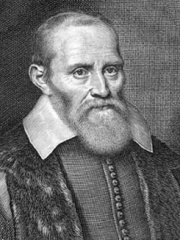
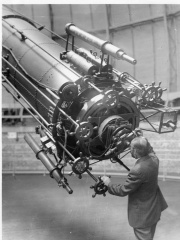
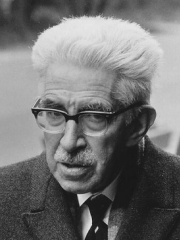
The Most Famous
ASTRONOMERS from Belgium
This page contains a list of the greatest Belgian Astronomers. The pantheon dataset contains 644 Astronomers, 9 of which were born in Belgium. This makes Belgium the birth place of the 14th most number of Astronomers behind Switzerland, and Denmark.
Top 9
The following people are considered by Pantheon to be the most legendary Belgian Astronomers of all time. This list of famous Belgian Astronomers is sorted by HPI (Historical Popularity Index), a metric that aggregates information on a biography's online popularity.

1. Adolphe Quetelet (1796 - 1874)
With an HPI of 71.63, Adolphe Quetelet is the most famous Belgian Astronomer. His biography has been translated into 41 different languages on wikipedia.
Lambert Adolphe Jacques Quetelet FRSF or FRSE (French: [kətlɛ] ; 22 February 1796 – 17 February 1874) was a Belgian-French astronomer, mathematician, statistician and sociologist who founded and directed the Brussels Observatory and was influential in introducing statistical methods to the social sciences. His name is sometimes spelled with an accent as Quételet. He also founded the science of anthropometry and developed the body mass index (BMI) scale, originally called the Quetelet Index. His work on measuring human characteristic to determine the ideal l'homme moyen ("the average man"), played a key role in the origins of eugenics.

2. Ferdinand Verbiest (1623 - 1688)
With an HPI of 68.87, Ferdinand Verbiest is the 2nd most famous Belgian Astronomer. His biography has been translated into 29 different languages.
Ferdinand Verbiest, (9 October 1623 – 28 January 1688) was a Flemish Jesuit missionary in China during the Qing dynasty. He was born in Pittem near Tielt in the County of Flanders (now part of Belgium). He is known as Nan Huairen (南懷仁) in Chinese. He was an accomplished mathematician and astronomer and proved to the court of the Kangxi Emperor that European astronomy was more accurate than Chinese astronomy. He then corrected the Chinese calendar and was later asked to rebuild and re-equip the Beijing Ancient Observatory, being given the roles of Head of the Mathematical Board and Director of the Observatory. He became close friends with the Kangxi Emperor, who frequently requested his instruction in geometry, philosophy and music. Verbiest worked as a diplomat, cartographer, and translator; he spoke Latin, German, Dutch, Spanish, Hebrew, Italian and Manchu. He wrote more than thirty books. During the 1670s, Verbiest designed what some claim to be the first ever self-propelled vehicle, in spite of its small size, not being able to carry a driver or goods, and the lack of evidence that it was actually built. He died in 1688. He was granted the posthumous name "Qínmǐn" (勤敏) by Kangxi Emperor.

3. Petrus Plancius (1552 - 1622)
With an HPI of 67.62, Petrus Plancius is the 3rd most famous Belgian Astronomer. His biography has been translated into 36 different languages.
Petrus Plancius (Dutch: [ˈpeːtrʏs ˈplɑŋkijʏs]; born Pieter Platevoet [ˈpitər ˈplaːtəvut]; 1552 – 15 May 1622) was a Dutch-Flemish astronomer, cartographer and clergyman. Born in Dranouter, now in Heuvelland, West Flanders, he studied theology in Germany and England. At the age of 24 he became a minister in the Dutch Reformed Church. Plancius fled from Brussels to Amsterdam to avoid religious persecution by the Inquisition after the city fell into Spanish hands in 1585. In Amsterdam he became interested in navigation and cartography and, having access to nautical charts recently brought from Portugal, he was soon recognized as an expert on safe maritime routes to India and the nearby "spice islands". This enabled colonies and port trade in both, including what would become the Dutch East Indies, named after the Dutch East India Company set up in 1602. He saw strong potential in the little-mapped Arctic Sea and strongly believed in the idea of a Northeast Passage until the failure of Willem Barentsz's third voyage in 1597 seemed to preclude its viability.

4. Eric Walter Elst (1936 - 2022)
With an HPI of 66.33, Eric Walter Elst is the 4th most famous Belgian Astronomer. His biography has been translated into 33 different languages.
Eric Walter Elst (30 November 1936 – 2 January 2022) was a Belgian astronomer at the Royal Observatory of Belgium in Uccle and a prolific discoverer of asteroids. The Minor Planet Center ranks him among the top 10 discoverers of minor planets with thousands of discoveries made at ESO's La Silla Observatory in northern Chile and at the Rozhen Observatory in Bulgaria during 1986–2009. The minor planet 3936 Elst, a stony Vestian asteroid from the inner regions of the asteroid belt, roughly 6 kilometers in diameter, was named in his honour.

5. Eugène Joseph Delporte (1882 - 1955)
With an HPI of 65.93, Eugène Joseph Delporte is the 5th most famous Belgian Astronomer. His biography has been translated into 33 different languages.
Eugène Joseph Delporte (10 January 1882 – 19 October 1955) was a Belgian astronomer born in Genappe. He discovered a total of sixty-six asteroids. Notable discoveries include 1221 Amor (which lent its name to the Amor asteroids) and the Apollo asteroid 2101 Adonis. He discovered or co-discovered some comets as well, including periodic comet 57P/du Toit-Neujmin-Delporte. He worked in the Observatoire Royal de Belgique (Belgian Royal Observatory), situated in the town of Uccle (after which the asteroid 1276 Ucclia is named). He started there in 1903 after receiving his doctorate that year from the Free University of Brussels. In 1930 he published, on behalf of the IAU, a work delineating the modern boundaries between all of the 88 official constellations in the sky, along lines of constant right ascension and declination for the epoch B1875.0. The Florian asteroid 1274 Delportia (discovered by himself) and the lunar impact crater Delporte were named after him.

6. Henri Debehogne (1928 - 2007)
With an HPI of 62.82, Henri Debehogne is the 6th most famous Belgian Astronomer. His biography has been translated into 27 different languages.
Henri Debehogne (30 December 1928 – 9 December 2007) was a Belgian astronomer and a prolific discoverer of minor planets.

7. Philippe van Lansberge (1561 - 1632)
With an HPI of 60.27, Philippe van Lansberge is the 7th most famous Belgian Astronomer. His biography has been translated into 18 different languages.
Johan Philip Lansberge (25 August 1561 – 8 December 1632) was a Flemish Calvinist Minister, astronomer and Mathematician. His name is sometimes written Lansberg, and his first name is sometimes given as Philip or Johannes Philippus. He published under the Latin name Philippus Lansbergius. He is best known as the author of a set of astronomical tables, Tabulae motuum coelestium perpetuæ, for predicting planetary positions. These were later found to contain certain errors, in part because he (erroneously) did not accept Kepler's discovery of elliptical orbits. He served as a Protestant clergyman. Martinus Hortensius was one of his students, and Landsberge subsequently collaborated with his former pupil. He was born in Ghent in modern-day Belgium in 1561. He grew up in France and studied in England. After the Fall of Antwerp in 1585, he moved to the northern part of the Netherlands. He stayed in Leiden for a short time, and then he went to Goes to become a preacher. Lansbergen lived there until 1613. In that year, he was fired because he did not agree with a mayoral election. The fifty-two-year-old Lansbergen decided to move to Middelburg to devote himself to astronomical research, which he did until the end of his life. Lansbergen supported the heliocentric theory of Copernicus, who claimed that the Earth revolves around the Sun. This theory was controversial in both Catholic and Protestant circles, where the geocentric theory had been more widely held. He married Sara Lievaerts in 1586 and they had six sons and four daughters. He had a great reputation, because of his rare knowledge and expertise. Not only in matters of the church, but even more in mathematics and physics. In 1611, his son Pieter (1587) became a preacher in Goes. Jacob, another son, moved to Goes as well, but became a medical doctor. Lansbergens' oldest son, also called Philippus, was a preacher in Kloetinge and died there in 1647. Lansbergen wrote several books. One of those, "Considerations about the daily and yearly movements of the Earth", became a best-seller. One could say that Lansbergen was the first Dutch author that wrote a popular book about the movements of the planets around the Sun. Kepler and Galileo, who lived in the same period, were very interested in the work of Lansbergen. Based on his tables, they could predict the movements of the planets more accurately. Lansbergen probably lived in the "Spanjaardstraat" in Middelburg. He had frequent contacts with sympathizers, like the Dutch poet Jacob Cats. Cats wrote three poems about the "very wise, famous, and honored Philippus Lansbergen". He died in Middelburg in December 1632. The Philippus Lansbergen Public Observatory in Middleburg is named after him, and so is the lunar crater Lansberg.

8. George Van Biesbroeck (1880 - 1974)
With an HPI of 59.71, George Van Biesbroeck is the 8th most famous Belgian Astronomer. His biography has been translated into 21 different languages.
George A. Van Biesbroeck (or Georges-Achille Van Biesbroeck, , January 21, 1880 – February 23, 1974) was a Belgian–American astronomer. He worked at observatories in Belgium, Germany and the United States. He specialized in the observation of double stars, asteroids and comets. He is notable for his long career as an observational astronomer.

9. Marcel Minnaert (1893 - 1970)
With an HPI of 57.47, Marcel Minnaert is the 9th most famous Belgian Astronomer. Her biography has been translated into 19 different languages.
Marcel Gilles Jozef Minnaert (12 February 1893 – 26 October 1970) was a Belgian-Dutch astronomer. He was born in Bruges and died in Utrecht. He is notable for his contributions to astronomy and physics and for a popular book on meteorological optics: Light and colour in the open air, first published in English in 1940.
People
Pantheon has 9 people classified as Belgian astronomers born between 1552 and 1936. Of these 9, none of them are still alive today. The most famous deceased Belgian astronomers include Adolphe Quetelet, Ferdinand Verbiest, and Petrus Plancius.
Deceased Belgian Astronomers
Go to all RankingsAdolphe Quetelet
1796 - 1874
HPI: 71.63
Ferdinand Verbiest
1623 - 1688
HPI: 68.87
Petrus Plancius
1552 - 1622
HPI: 67.62
Eric Walter Elst
1936 - 2022
HPI: 66.33
Eugène Joseph Delporte
1882 - 1955
HPI: 65.93
Henri Debehogne
1928 - 2007
HPI: 62.82
Philippe van Lansberge
1561 - 1632
HPI: 60.27
George Van Biesbroeck
1880 - 1974
HPI: 59.71
Marcel Minnaert
1893 - 1970
HPI: 57.47
Overlapping Lives
Which Astronomers were alive at the same time? This visualization shows the lifespans of the 6 most globally memorable Astronomers since 1700.

